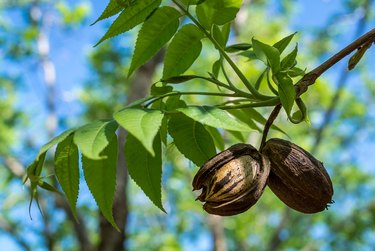
There are various ways to grow pecan trees (Carya illinoinensis, USDA zones 5a to 9a) at home, including transplanting and grafting from seedlings, but one of the most inexpensive ways to grow pecan trees is from pecan nuts. No, you can't just pop one out of your grandma's pecan pie and put it in the ground, but you can prepare the nuts yourself for planting. Some people like to grow pecan trees for their shade, but if you want to grow them to produce nuts, there's an extra step you'll need to know. Here's what you need to know about how to start pecan trees from nuts.
Things You'll Need
Pecan nuts (seeds)
Tub for water
Plant pot with drainage holes
Net or chicken wire (optional)
Video of the Day
How to Start Pecan Trees From Nuts
Step 1: Choose a Good Seed
Collect pecan seeds (nuts) in the fall, ideally from trees that actively produce nuts, but you can also buy these from garden centers. Select those that are well filled (i.e., not shriveled or wrinkled) and free of insects. Collect more than you think you'll need because some seeds may turn out not to be ideal.
Video of the Day
Tip
Pecan nuts are actually the seeds of the tree. They're not nuts in the botanical sense of the word and would be better called tree nuts.
Step 2: Soak the Pecans and Vermiculite
Pecan nuts need to be stratified. Stratification is the process of pretreating seeds to imitate the natural conditions they would experience in the soil during winter. This helps initiate the germination process, reduces the germination time, and allows for more uniform germination.
To stratify the pecan nuts, fill a tub with cold tap water. Soak the nuts in the water for 24 hours so they become fully hydrated. At the same time, place some vermiculite into a plant pot with drainage holes. Wet the vermiculite with water and leave it to drain. You'll want the vermiculite to be moist but not soaking wet when it's ready to use.
Tip
Stratified pecan nuts should be planted in spring after the threat of frost has passed. Keep this timing in mind when starting the stratification process, which should take between two and six months, and work backward. If you live in a colder climate, you may need to wait until mid-May until it's safe to plant the seeds, whereas if you're in a warmer climate, this may be safe as early as March 1.
Step 3: Combine and Refrigerate the Pecans and Vermiculite
Mix the soaked pecan nuts and the damp vermiculite together in a sealable plastic bag. Place the bag in a cold place, such as a refrigerator, at 36 to 40 degrees Fahrenheit. Leave it for at least two months and up to six months.
Step 4: Choose the Right Place in Your Garden
The planting site of your pecan nut seeds should be spacious enough that the tree can grow big without being crowded, as pecan trees can grow up to 75 feet tall. It should be in full sun and have deep, well-drained soil with plenty of water.
Step 5: Plant the Seeds
Plant the nuts in the ground on their side at a depth of around 1 to 1 1/2 inches. Cover them carefully with soil. If you think mice, birds, squirrels, or raccoons could be a problem in your area, cover the seedlings with a net or chicken-wire cage.
Tip
Pecans are monoecious plants, meaning that both male and female flowers appear on the same tree. However, self-pollination is limited, and to produce nuts, you'll need trees that will pollinate each other within a quarter of a mile of your planted pecan nut. If you know you live in an area with plenty of other pecan trees around, such as in your neighbors' gardens, then you could plant a single pecan tree and still potentially get nuts. However, if you're not sure, it would be safe to plant several trees yourself to make sure your tree is pollinated at the right time.
Step 6: Fertilize and Maintain the Seedlings
Once the seedlings from the nuts have grown to 2 to 3 inches and have at least two true leaves, you can apply a slow-release fertilizer according to the manufacturer's instructions. Hand weed the area around the seedlings so they don't have to compete for space and nutrients with other unwanted plants.